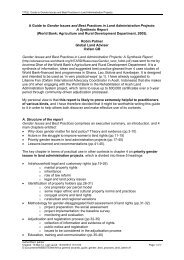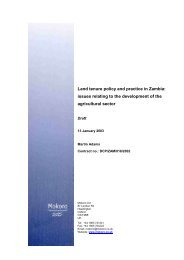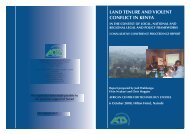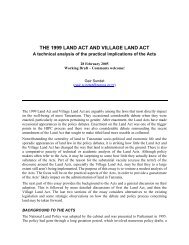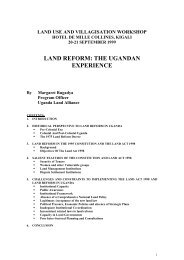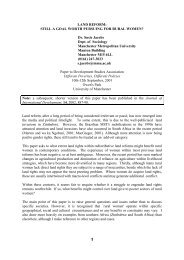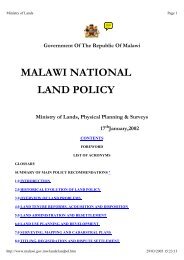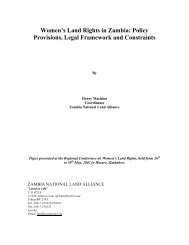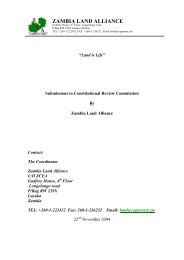Download - Mokoro
Download - Mokoro
Download - Mokoro
- No tags were found...
Create successful ePaper yourself
Turn your PDF publications into a flip-book with our unique Google optimized e-Paper software.
26system of M&E and capturing more extensive beneficiary and projectinformation during the project approval stage.The DLA should produce QOL reports on an annual basis, using astandard set of survey instruments to reflect the impact of land reformover time. The reports should be extended to assessing the resourcescommitted to the delivery of land reform, including staff capacity, capitaland operating budgets, and contributions from other governmentdepartments, parastatal and local government institutions.The QOL survey should be extended to include a control group of ruralhouseholds and communities that have not benefited from land reform.This will enable future reports to compare improvements in the quality oflife of land reform participants to other rural populations (DLA 2003 xxxii).The QOL studies have shown that those in the programme are better off than the ruralpopulation as a whole; but are they better off because they are land reform beneficiaries;or did they manage to become land reform beneficiaries because they are better off?Those who are richer are more likely to have cattle; but are they richer because theyhave cattle, or do they have cattle because they are richer? Redistribution policy, unlikerestitution policy, is based on the presumption that the presence of an own contributioncan have a positive impact on projects, as a sign of commitment, but this proposition hasnot been empirically tested. As Murray observed in the Free State, those who are bestplaced to participate in the land reform programme, and predominated in an early studyof land reform, were those who were literate, had their own disposable resources withwhich to pursue their applications, had access to telecommunications, to transport, hadaccess to officialdom, and have social and political networks (Murray 1997).In summary, there remain both technical and conceptual challenges in determininglivelihood impacts within the context of South Africa’s land reform programme. Existingdata from the QOL studies on the livelihoods of land reform beneficiaries demonstratesimportant correlations, but on the whole fail to demonstrate causal relations that tell ussomething about the ability of land reform to improve people’s livelihoods and lift themout of poverty.In the absence of baseline data – a profile of people entering the programme –subsequent surveys can only provide a snapshot of people’s livelihoods, but cannotexplain how these have changed as a result of land reform. In addition to the “before”and “after” dimension, few if any studies have attempted to disentangle or evenadequately conceptualise on-project livelihoods in relation to people’s overall livelihoodstrategies – how land reform is one input into wider livelihood strategies – or to theorisethe relationship between the two. As a result, impact studies, which would investigatechanges over time and determine whether these can be attributed to land reform, havenot been possible.An audit of land reform projects in the North West province, by Kirsten and Machethe(2005) suggests that project failure can be largely ascribed not to operational problemsbut to inappropriate planning and the wider context. This review commissioned by theNational Department of Agriculture assessed “the extent to which land reform projectsare meeting or not meeting the agrarian reform objective of commercial viability”Policy Options for Land and Agrarian ReformProgramme for Land and Agrarian Studies, University of the Western Cape




